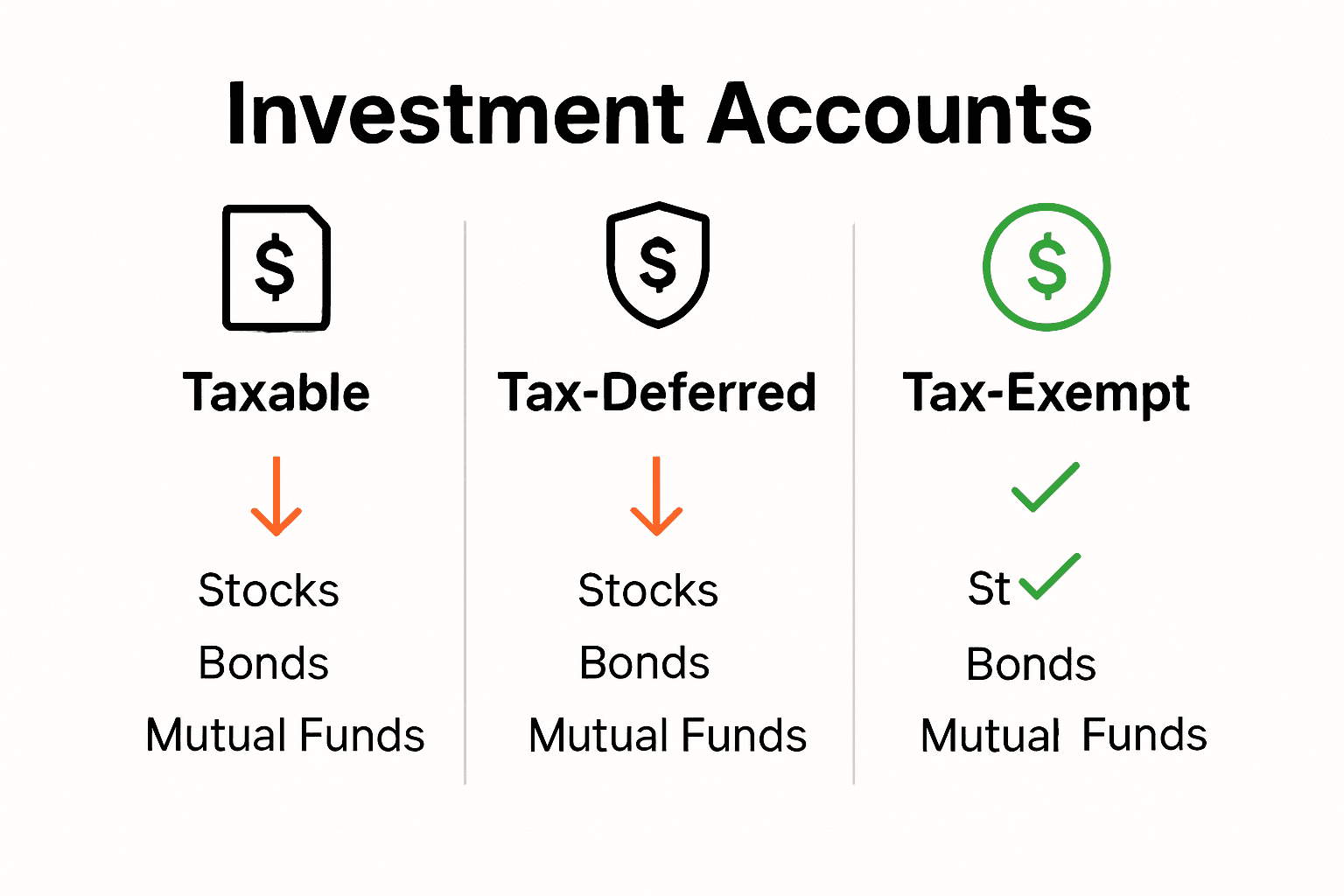Did you know the IRS collected over $4.9 trillion in taxes last year? For investors, even a small misstep can lead to paying far more than necessary. The way you manage investments often determines how much of your earnings you keep after taxes. By understanding smart strategies and how different assets are taxed, you can hold onto more of your hard-earned wealth and avoid unpleasant surprises from the taxman.
Table of Contents
- Tax Efficiency in Investments Defined
- Key Strategies for Maximizing Tax Benefits
- Investment Vehicles and Tax Implications
- Global Tax Considerations for UHNW Investors
- Compliance, Reporting, and Common Pitfalls
Key Takeaways
| Point | Details |
|---|---|
| Tax Efficiency | Focus on strategic asset placement across account types to minimize tax liability and enhance after-tax returns. |
| Tax Diversification | Allocate assets among different account types to maximize flexibility and reduce potential tax burdens. |
| Tax-Loss Harvesting | Sell underperforming investments to offset capital gains, effectively managing tax liability while staying invested. |
| Global Tax Considerations | UHNW investors must understand international tax laws and compliance to optimize worldwide investment strategies. |
Tax Efficiency in Investments Defined
Tax efficiency represents a sophisticated investment strategy focused on legally minimizing tax liability while maximizing investment returns. According to Wikipedia, this approach centers on strategic asset placement across different account types to optimize after-tax performance.
At its core, tax efficiency involves careful asset location strategies that distribute investments across taxable, tax-deferred, and tax-exempt accounts. This nuanced approach considers each investment’s unique tax characteristics to reduce overall tax burden. Sophisticated investors understand that not all investment vehicles are taxed equally – some generate more immediate tax consequences while others offer potential long-term tax advantages.
Key components of tax efficiency include:
- Strategically positioning high-yield investments in tax-advantaged accounts
- Minimizing frequent trading to reduce short-term capital gains
- Utilizing tax-loss harvesting techniques
- Understanding the tax implications of different investment strategies
Unlike active management approaches that frequently trade assets potentially triggering significant tax events, tax-efficient investing prioritizes strategic, methodical asset placement. As research from Wikipedia indicates, active management can generate substantial tax liabilities through frequent buying and selling, making tax efficiency a critical consideration for sophisticated wealth preservation strategies.
Key Strategies for Maximizing Tax Benefits
Tax diversification is a powerful approach for sophisticated investors seeking to optimize their investment portfolio’s tax efficiency. According to research from Ameriprise Advisors, this strategy involves strategically allocating assets across different account types to provide maximum flexibility and minimize potential tax liabilities.
One primary strategy is maximizing contributions to tax-advantaged accounts like 401(k)s and IRAs. These investment vehicles offer significant tax benefits by reducing current taxable income and allowing investments to grow tax-deferred. As insights from Sager CPA suggest, proactive investors can substantially lower their annual tax burden through strategic retirement account contributions.
Key tax optimization techniques include:
- Maximizing contributions to tax-advantaged retirement accounts
- Implementing tax-loss harvesting to offset capital gains
- Balancing investments across taxable and tax-exempt accounts
- Timing investment sales to minimize tax implications
Tax-loss harvesting represents another sophisticated technique where investors strategically sell underperforming investments to offset capital gains. This approach allows investors to reduce their overall tax liability while maintaining a robust and dynamic investment portfolio. By continuously evaluating and adjusting investment strategies, savvy investors can create a more tax-efficient wealth management approach that preserves and grows their financial resources.

Investment Vehicles and Tax Implications
Asset location is a critical strategy for minimizing tax liability across different investment vehicles. According to Wikipedia, strategic placement of investments can significantly impact overall tax efficiency, with specific account types offering unique tax advantages for various asset classes.
Investors must carefully consider the tax characteristics of different investment vehicles. High-yield bonds, for example, are typically best placed in tax-advantaged accounts to shield interest income from immediate taxation. Conversely, equities might be more strategically positioned in taxable accounts to take advantage of lower long-term capital gains tax rates. This nuanced approach requires a deep understanding of each investment’s unique tax implications.
Here’s a summary of how different account types impact tax efficiency:

| Account Type | Tax Treatment | Best for Assets |
|---|---|---|
| Taxable | Taxes on gains annually | Equities Index Funds |
| Tax-Deferred | Taxes upon withdrawal | Bonds REITs |
| Tax-Exempt | No taxes on qualified gains | Municipal Bonds Roth assets |
Key considerations for tax-efficient investment vehicles include:
- Differentiating between actively and passively managed funds
- Understanding the tax impact of investment turnover
- Identifying tax-advantaged account opportunities
- Balancing between tax-exempt and taxable investment options
As research from Wikipedia highlights, actively managed funds often generate more frequent taxable events due to higher trading volumes. These funds typically have increased turnover rates, which can result in more significant tax liabilities compared to passively managed index funds. Sophisticated investors carefully evaluate these tax implications, recognizing that the most tax-efficient investment strategy goes beyond simple return calculations and requires a comprehensive understanding of how different investment vehicles interact with the tax system.
Global Tax Considerations for UHNW Investors
Base erosion and profit shifting represents a complex landscape of international tax strategies that ultra-high-net-worth (UHNW) investors must carefully navigate. According to Wikipedia, this phenomenon involves sophisticated methods of shifting profits between jurisdictions to optimize tax liability, requiring intricate understanding of global tax regulations.
International tax planning goes beyond simple geographic arbitrage. Sophisticated investors analyze multiple factors, including tax treaty networks, jurisdictional tax rates, and potential legal frameworks that impact cross-border investments. The Tax Attractiveness Index provides critical insights into evaluating different countries’ tax environments, helping investors make informed decisions about asset placement and investment strategies.
Key global tax considerations for UHNW investors include:
- Understanding complex international tax treaty frameworks
- Analyzing potential tax implications of cross-border investments
- Evaluating jurisdictional tax rates and incentives
- Maintaining compliance with international reporting requirements
- Implementing legal tax optimization strategies
While legal tax optimization strategies exist, UHNW investors must remain vigilant about maintaining full transparency and compliance. The intricate nature of global tax regulations demands a proactive approach, combining deep financial expertise with comprehensive understanding of international tax landscapes. Successful global tax management requires continuous monitoring of changing regulations, strategic planning, and a sophisticated approach to wealth preservation across multiple jurisdictions.
Compliance, Reporting, and Common Pitfalls
Tax compliance represents a critical challenge for sophisticated investors navigating the complex landscape of financial regulations. According to insights from Business Initiative, consulting a tax professional is crucial, as tax regulations continuously evolve and require specialized expertise to manage effectively.
Investors must develop a proactive approach to tax reporting and risk management. Investment diversification plays a key role in managing potential compliance risks. As research from Data Calculus suggests, spreading investments across multiple asset classes and geographic regions can help optimize tax scenarios while mitigating potential reporting complications.
Common compliance pitfalls for investors include:
- Failing to maintain accurate and comprehensive financial records
- Overlooking emerging tax regulation changes
- Inadequate documentation of cross-border transactions
- Misunderstanding complex reporting requirements
- Neglecting to leverage available tax credits and deductions
Successful tax compliance requires a multifaceted strategy that combines professional guidance, meticulous record-keeping, and a comprehensive understanding of evolving regulatory landscapes. Sophisticated investors recognize that proactive management and continuous education are essential to navigating the intricate world of tax reporting and maintaining financial integrity.
Master Tax Efficiency with Future Family Office Resources
Navigating the complex world of tax efficiency requires more than knowledge. It demands access to a powerful network and expert resources tailored for ultra-high-net-worth investors and family offices. This article highlights critical challenges such as strategic asset location, global tax compliance, and optimizing tax-advantaged investments — areas where common pitfalls can drastically impact wealth preservation.

Unlock solutions designed to help you conquer these tax challenges at Future Family Office. Connect with industry-leading service providers, discover insightful reports on tax strategies, and engage with a global community focused on maximizing after-tax returns. Act now to ensure your investment approach aligns with sophisticated tax planning techniques by exploring our platform and accessing curated expert articles dedicated to the evolving tax efficiency landscape.
Frequently Asked Questions
What is tax efficiency in investments?
Tax efficiency in investments refers to strategies aimed at legally minimizing tax liability while maximizing returns by strategically placing assets across different account types.
How can I maximize tax efficiency in my investment portfolio?
You can maximize tax efficiency by utilizing tax-advantaged accounts, implementing tax-loss harvesting, diversifying across taxable and tax-exempt accounts, and considering the timing of investment sales.
What are the main strategies for tax loss harvesting?
Main strategies for tax loss harvesting include selling underperforming investments to offset capital gains, continuously evaluating your investment portfolio, and maintaining a balance between realizing gains and losses.
Why is asset location important for tax efficiency?
Asset location is important because different account types offer unique tax advantages for various asset classes, significantly impacting overall tax efficiency and helping to minimize tax liabilities.
Recommended
- When Cash Is Not King: The New Favorite Investment Options For Family Offices – Future Family Office
- 5 Family Offices Making Impact Investments – Future Family Office
- January 2020 Family Office Data Report – Future Family Office
- 5 Reasons Why Family Offices Are Focusing On Direct Investments – Future Family Office




